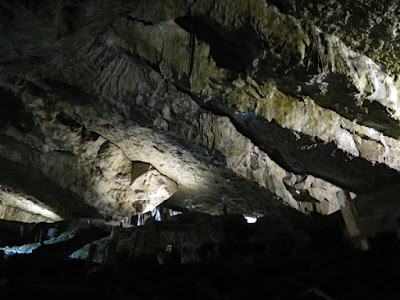 |
| Flowstone and stalagmites in the Poached Egg Chamber |
After a busy start to 2019, preparing the visit to Leeds to look at its building stones and then visiting mediaeval churches in Dronfield and Adwick le Street, and Selby Abbey, I then prepared a talk for the Friends of Rotherham Archives – partially based on the one I had given a year earlier to Aston-cum-Aughton History Group, which highlighted a few mediaeval churches that are built of Rotherham Red sandstone.
 |
| At the entrance of Poole's Cavern |
My next trip out, a couple of weeks later, was with the Sheffield U3A Geology Group to Poole's Cavern, a show cave that was developed as a tourist attraction in 1853 by the 6th Duke of Devonshire, to complement the thriving spa town of Buxton nearby, which his predecessor, the 5th Duke, had established using the profits of his copper mines at Ecton.
 |
| Entering the cavern |
Having visited Peak Cavern and Treak Cliff Cavern in Castleton and the Nottingham Castle caves with groups of Spanish students, as part of their English language summer schools, and being quite disappointed with what I saw, I was hoping that this would be a much better experience.
 |
| A general view of the cavern roof |
Starting with an introduction by our nonstop speaking guide outside the entrance, I have to say that, from this moment onward, I stood back from the group and decided to treat this trip as an exercise in taking photographs in light conditions that stretched my Canon Powershot G16 camera to its limits.
 |
| A general view of the ubiquitous flowstone |
Although the cave has a very interesting history, I was much more interested in the various formations that could be seen in the Carboniferous limestone, which included ubiquitous flowstone on the cavern walls and examples of stalactites and stalagmites that are considered to be the longest in Derbyshire.
 |
| Stalagmites in the Poached Egg Cavern |
The part of the cave known as the Poached Egg Chamber, was described by our guide as being unique, with their yellow/orange colour and extremely fast rate of growth. This has been attributed to the percolation of water saturated with calcium carbonate from the lime burning industry that took place at Grin Low on the surface above the caves.
 |
| A general view of flowstone |
The cave system open to the public is much more extensive than those in Castleton and it also contains a fast flowing underground water course that forms part of the system that feeds the River Wye, and which is designated as a Site of Special Scientific Interest.
 |
| A general view |
By 11:30, our tour had finished and after having a quick look at the displays in the visitor centre, which had some interesting artefacts collected from the caves - which include a petrified rook's nest - we had a very leisurely lunch in the sunshine, before walking up to Solomon’s Temple.
 |
| Various artefacts and curiosities on display in the visitor centre |
No comments:
Post a Comment